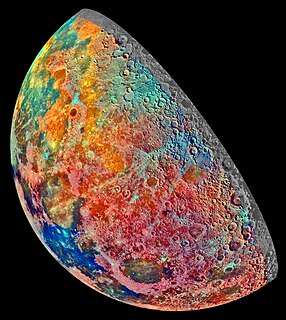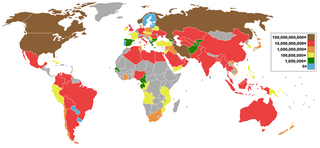 W
WNatural resources are resources that exist without any actions of humankind. This includes all valued characteristics such as commercial and industrial use, aesthetic value, scientific interest and cultural value. On Earth, it includes sunlight, atmosphere, water, land along with all vegetation, and animal life.
 W
WAsteroid mining is the exploitation of raw materials from asteroids and other minor planets, including near-Earth objects.
 W
WEcological economics, bioeconomics, ecolonomy, or eco-economics, is both a transdisciplinary and an interdisciplinary field of academic research addressing the interdependence and coevolution of human economies and natural ecosystems, both intertemporally and spatially. By treating the economy as a subsystem of Earth's larger ecosystem, and by emphasizing the preservation of natural capital, the field of ecological economics is differentiated from environmental economics, which is the mainstream economic analysis of the environment. One survey of German economists found that ecological and environmental economics are different schools of economic thought, with ecological economists emphasizing strong sustainability and rejecting the proposition that physical (human-made) capital can substitute for natural capital.
 W
WEnergy quality is a measure of the ease at which a form of energy can be converted to useful work or to another form of energy. A high quality form of energy is easily converted to work or to a lower quality form of energy, whereas converting low quality forms of energy to work or a higher quality form may be inefficient, difficult or impossible. The concept of energy quality is also used in ecology, where it is used to track the flow of energy between different trophic levels in a food chain and in thermoeconomics, where it is used as a measure of economic output per unit of energy. Methods of evaluating energy quality often involve developing a ranking of energy qualities in hierarchical order.
 W
WThe exploitation of natural resources is the use of natural resources for economic growth, sometimes with a negative connotation of accompanying environmental degradation. It started to emerge on an industrial scale in the 19th century as the extraction and processing of raw materials developed much further than it had in preindustrial areas. During the 20th century, energy consumption rapidly increased. Today, about 80% of the world's energy consumption is sustained by the extraction of fossil fuels, which consists of oil, coal and gas. Another non-renewable resource that is exploited by humans is subsoil minerals such as precious metals that are mainly used in the production of industrial commodities. Intensive agriculture is an example of a mode of production that hinders many aspects of the natural environment, for example the degradation of forests in a terrestrial ecosystem and water pollution in an aquatic ecosystem. As the world population rises and economic growth occurs, the depletion of natural resources influenced by the unsustainable extraction of raw materials becomes an increasing concern.
 W
WExtractivism is the process of extracting natural resources from the Earth to sell on the world market. It exists in an economy that depends primarily on the extraction or removal of natural resources that are considered valuable for exportation worldwide. Some examples of resources that are obtained through extraction include gold, diamonds, lumber and oil. This economic model has become popular in many Latin American countries but is becoming increasingly prominent in other regions as well.
 W
WThe power generation potential of the rivers in Azerbaijan is estimated at 40 billion kilowatt per hour, and feasible potential is 16 billion kilowatt per hour. Small-scale hydro has significant developmental potential in Azerbaijan. In particular, the lower reaches of the Kura river, the Aras river and other rivers flowing into the Caspian Sea. Hydropower could conceivably provide up to 30% of Azerbaijan’s electricity requirements. Currently, hydropower, dominated by large-scale dams, provides 11.4% of Azerbaijan’s electricity.
 W
WIn space exploration, in situ resource utilization (ISRU) is the practice of collection, processing, storing and use of materials found or manufactured on other astronomical objects that replace materials that would otherwise be brought from Earth.
 W
WLand cover is the physical material at the surface of the earth. Land covers include grass, asphalt, trees, bare ground, water, etc. Earth cover is the expression used by ecologist Frederick Edward Clements that has its closest modern equivalent being vegetation. The expression continues to be used by the United States Bureau of Land Management.
 W
WThe Moon bears substantial natural resources which could be exploited in the future. Potential lunar resources may encompass processable materials such as volatiles and minerals, along with geologic structures such as lava tubes that together, might enable lunar habitation. The use of resources on the Moon may provide a means of reducing the cost and risk of lunar exploration and beyond.
 W
WNatural capital is the world's stock of natural resources, which includes geology, soils, air, water and all living organisms. Some natural capital assets provide people with free goods and services, often called ecosystem services. Two of these underpin our economy and society, and thus make human life possible.
 W
WThe Natural Capital Initiative (NCI) is a partnership of UK organisations which promotes and supports decision-making across government, business and the private sector that results in the sustainable management of our natural capital. Formed in 2009, it is a partnership between two of the UK's learned societies and two of its scientific research institutes, namely:Centre for Ecology and Hydrology Royal Society of Biology British Ecological Society James Hutton Institute.
 W
WThis list of natural gas fields includes major fields of the past and present.
 W
WA non-renewable resource is a natural resource that cannot be readily replaced by natural means at a quick enough pace to keep up with consumption. An example is carbon-based fossil fuel. The original organic matter, with the aid of heat and pressure, becomes a fuel such as oil or gas. Earth minerals and metal ores, fossil fuels and groundwater in certain aquifers are all considered non-renewable resources, though individual elements are always conserved.
 W
WSoil is a mixture of organic matter, minerals, gases, liquids, and organisms that together support life. Earth's body of soil, called the pedosphere, has four important functions:as a medium for plant growth as a means of water storage, supply and purification as a modifier of Earth's atmosphere as a habitat for organisms
 W
WWater, Land and Ecosystems is one of several new research programmes approved by the CGIAR during 2011 after an extensive period of consultation that began in 2009. This research programme will draw on the resources of 14 CGIAR and numerous external partners to provide a more integrated approach to research into managing natural resources. The aim of the research programme is to increase agricultural productivity while protecting the environment, so food security is ensured for most of humanity and that poverty becomes history. The five main strands to the programme are: River basins; Irrigation systems; Information systems; Resource reuse and recovery; and Rainfed agriculture systems.
 W
WWood is a porous and fibrous structural tissue found in the stems and roots of trees and other woody plants. It is an organic material – a natural composite of cellulose fibers that are strong in tension and embedded in a matrix of lignin that resists compression. Wood is sometimes defined as only the secondary xylem in the stems of trees, or it is defined more broadly to include the same type of tissue elsewhere such as in the roots of trees or shrubs. In a living tree it performs a support function, enabling woody plants to grow large or to stand up by themselves. It also conveys water and nutrients between the leaves, other growing tissues, and the roots. Wood may also refer to other plant materials with comparable properties, and to material engineered from wood, or wood chips or fiber.